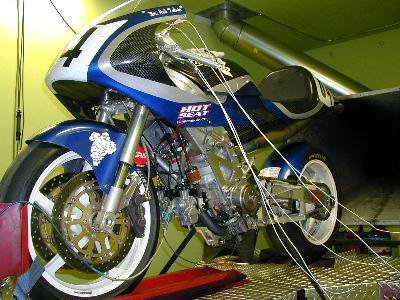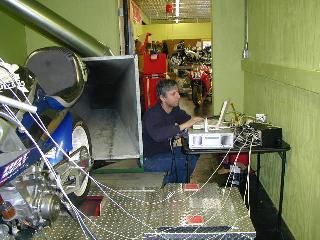

Vibration Testing of the Tularis
Dr. Robin Tuluie lives in Minneapolis and works at MTS. I can't remember when or how we met, but it was through one of those motorcycle/racing community things. He doesn't make a fuss about having a Doctorate in Astrophysics, but he spent what, to most of us, would have been our mis-spent youth, in school, so he deserves the title. Fortunately, he responds very well to shouts of 'Rob'!
The CNC machining on the Tularis was being done just down the street from my old shop, so when the time came to start the tuning the engine, he approached me. At that time everything about the project was hush-hush, so we just got the thing running properly and it was taken to Daytona for a couple appearance laps. All of the information we collected was for Robs use only and I couldn't mention it to anyone. (Needless to say, a few locals saw the bike at the shop several times, but that was before the Roadracing World article so it was generally overlooked.)
Now that the project is higher profile, we can talk about it a little.
The project has been about the chassis, so engine development isn't so important. Besides, the snowmobile racers in general and Hot Seat Performance in particular, have done all of the performance development that needs to be done on the thing. All we needed to do was get the jets close.
The first time we ran it the engine was bone-stock. The power numbers were right in line with what you would expect considering that the snowmobile engines use a water-brake attached to the end of the crankshaft (thus the big-big HP numbers) and a motorcycle has a transmission and rear-drive as well as a rubber tire between the engine and the dyno drum.
Each time the engine was up-graded we put it back on the dyno to adjust the tune. Except for the last time, (over the Christmas Holidays) when he took it to Willow Springs for Speedvision, Motorcyclist, and Roadracing World to test. Fortunately, a few jet changes got it into the 'ball-park'.
Mike Ciccotto will probably be riding it for the 2001 season and he had an opportunity to ride it at Willow too. The only thing he found wrong with the bike was the vibration in the handle-bars. Therefore, we did a little testing the second week in January. I took the opportunity to take some pictures of the set-up.


Above you see the 'mighty Tularis' on the dyno This is Rob with the computer, power supplies, and signal conditioners
 Here is the whole plot.
Here is the whole plot.
The latest Roadracing World showed up and it was clear why Rob needed to address the handlebar vibration issue!
We tested into the night and Rob went away with oodles of data to 'crunch'.
The data should help to understand the characteristics of the bars we tested, and this will be the key to dealing with the vibration.
This article isn't about the vibration testing (very dry subject) it's really just a 'behind the scenes' look at the Tularis.